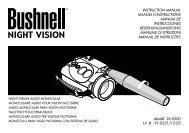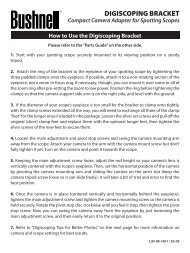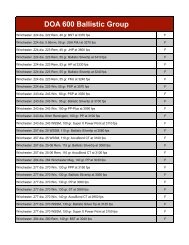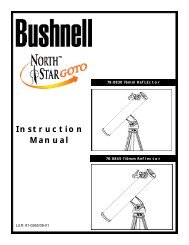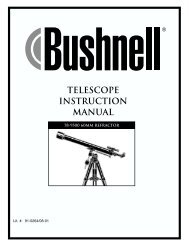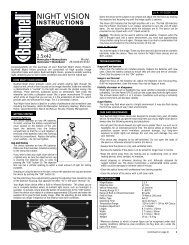PAGE GUIDE - Bushnell
PAGE GUIDE - Bushnell
PAGE GUIDE - Bushnell
You also want an ePaper? Increase the reach of your titles
YUMPU automatically turns print PDFs into web optimized ePapers that Google loves.
Where DO I STArT?<br />
your <strong>Bushnell</strong> telescope can bring the wonders of the universe to your eye. While this<br />
manual is intended to assist you in the set-up and basic use of this instrument, it does not<br />
cover everything you might like to know about astronomy. although discoverer will give<br />
a respectable tour of the night sky, it is recommended you get a very simple star chart and<br />
a flashlight with a red bulb or red cellophane over the end. for objects other than stars<br />
and constellations, a basic guide to astronomy is a must. some recommended sources<br />
appear on our website at www.bushnell.com. also on our website will be current events<br />
in the sky for suggested viewing. But, some of the standbys that you can see are:<br />
the moon—a wonderful view of our lunar neighbor can be enjoyed with any magnification.<br />
Try viewing at different phases of the moon. Lunar highlands, lunar maria (lowlands called<br />
“seas” for their dark coloration), craters, ridges and mountains will astound you.<br />
saturn—even at the lowest power you should be able to see Saturn’s rings and moons.<br />
This is one of the most satisfying objects in the sky to see simply because it looks like it<br />
does in pictures. Imagine seeing what you’ve seen in textbooks or NASA images from your<br />
backyard!<br />
Jupiter—the largest planet in our solar system is spectacular. Most noted features are its dark<br />
stripes or bands both above and below its equator. These are the north and south equatorial<br />
belts. Also interesting are Jupiter’s four major moons. Pay close attention to their positions<br />
from night to night. They appear to be lined up on either side of Jupiter.<br />
mars—The Great Red Planet appears as a reddish-orange disk. Look at different times of<br />
the year and try to catch a glimpse of the white polar ice caps.<br />
Venus—just like the moon, Venus changes phases from month to month. At times Venus<br />
appears brilliantly in the night sky, just as if you were looking at a distant crescent moon.<br />
nebulae—The Great Orion Nebula is a very well known night sky object. This and many<br />
others are brought to you by this telescope.<br />
star clusters—View millions of stars densely packed in a cluster that resembles a ball.<br />
galaxies—One of the greatest and most interesting galaxies is our neighbor the Andromeda<br />
Galaxy. Enjoy this and many others.





